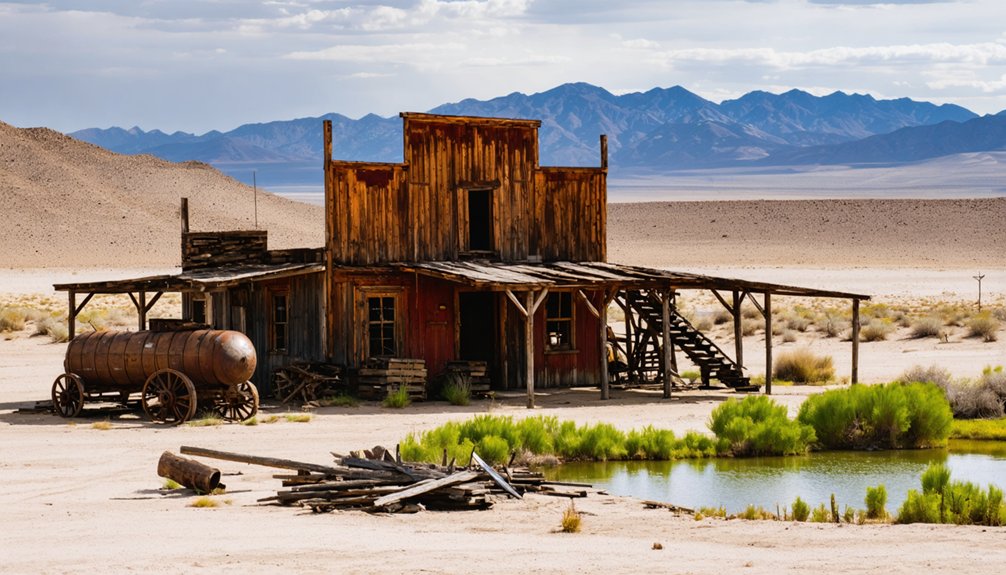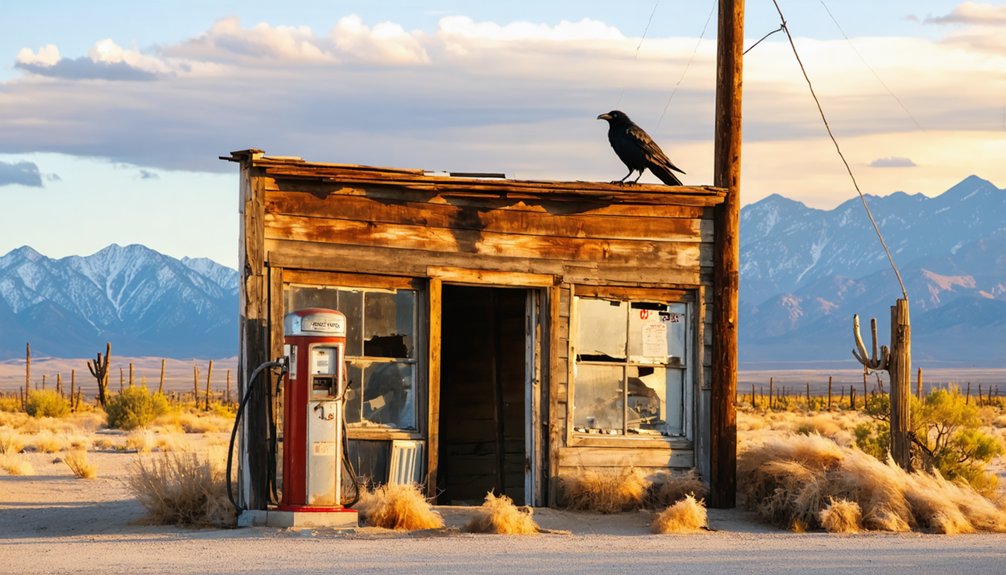You’ll find Benton nestled in California’s Mono County, where silver’s discovery in 1862 transformed a hot springs outpost into a bustling mining town of 5,000 prospectors. Its mines yielded silver worth $1,500 per ton, with Blind Spring Hill operations generating $9 million during the Civil War era. Though mining ceased by 1930, today’s Benton preserves its Wild West legacy through historic structures, a pioneer cemetery, and natural hot springs that still flow at 140°F.
Key Takeaways
- Benton transformed from a thriving 1860s mining town of 5,000 people to a ghost town following mine closures by 1930.
- The town’s economy centered on silver mining at Blind Spring Hill, which generated $9 million during the Civil War era.
- Today, fewer than 100 residents remain in Benton, with the Inn at Benton Hot Springs preserving historic buildings and offering accommodation.
- Historic structures built from pumice stone blocks still stand, including preserved mine cabins, a general store, and hotel.
- The pioneer cemetery, with 19th-century grave markers, serves as a testament to Benton’s mining era past.
The Birth of a Wild West Settlement
While indigenous peoples had thrived for thousands of years around Benton Hot Springs, the area’s transformation into a Wild West settlement began in the 1850s when white settlers first arrived.
Established in 1852, Benton became one of California’s earliest settlements.
The discovery of silver at Blind Spring Hill sparked rapid growth in the area, drawing prospectors and entrepreneurs seeking their fortunes.
You’d have found miners, farmers, and ranchers establishing themselves in this rugged terrain, leading to inevitable conflicts with the local Paiute tribe during the Owens Valley Indian War of the 1860s.
Silver Rush and Economic Prosperity
The discovery of silver in the Blind Springs Hills and White Mountains during the early 1860s transformed Benton from a modest settlement into a thriving mining hub.
Silver’s discovery in the Blind Springs region catapulted Benton from sleepy settlement to bustling mining center in the 1860s.
You’d find up to 1,000 miners working the area, extracting valuable ore worth $1,500 per ton that contained silver, copper, lead, and gold.
As silver mining operations expanded, Benton’s strategic location near the Carson and Colorado Railroad made it an essential supply center.
Similar to the Comstock Lode discovery, this region’s silver deposits were found primarily on the surface, making extraction easier initially.
You could see diverse groups of miners, including Chinese and Native American workers, contributing to the region’s prosperity.
The Blind Spring Hill mines alone generated $9 million during the Civil War era.
Miners would transport their ore in 5-gallon kerosene cans to waiting wagons for shipment.
However, economic fluctuations took their toll by the late 1920s, and falling silver prices during the Great Depression ultimately forced the mines to close by 1930.
Natural Treasures: The Healing Hot Springs
Long before silver drew prospectors to Benton, its healing hot springs attracted the Paiute people, who named themselves Utu Utu Gwaitu – meaning “Hot Water Place People.”
These natural springs produce an impressive 900 gallons per minute of mineral-rich water, maintaining temperatures between 135-140 degrees Fahrenheit.
The springs’ cultural significance extends far beyond their healing properties. For millennia, Native Americans used these pure waters for ceremonies, healing rituals, and agriculture.
Today, you’ll find these therapeutic waters powering modern amenities at the Inn at Benton Hot Springs, where you can soak in private tubs or deck-level spas.
The water temperature in these private soaking tubs can be adjusted by guests for optimal comfort.
The 900-acre Benton Hot Springs Ranch, conserved in 2008, protects these treasured waters while preserving historic buildings from the silver boom era.
Located just 30 minutes south of Mammoth, these springs continue to draw visitors seeking natural healing and relaxation.
Tales of Outlaws and Mysterious Events
Beyond Benton’s soothing hot springs lies a darker history marked by outlaws, violence, and mysterious events.
You’ll find tales of the infamous 1871 prison break when 27 inmates escaped from Nevada State Prison, leading to a deadly chase near what’s now known as Convict Lake. The outlaw legends include Charlie Jones and his gang, who murdered mail rider Billy Poor to avoid detection. Local storekeeper Robert Morrison joined the posse that pursued these dangerous escapees.
The area’s violent past extends to conflicts between settlers and Native Americans, primarily the siege of E.S. Taylor’s cabin, where he killed 10 natives before perishing. A devastating fire in 1885 destroyed many of the town’s wooden structures.
Today, these events fuel ghostly encounters at Benton Hot Springs, where visitors report paranormal activity.
Like its neighbor Bodie, Benton carries the weight of its lawless mining-era history, complete with tales of curses and restless spirits.
Architectural Legacy and Historic Structures
As you explore Benton’s architectural heritage, you’ll find distinctive pumice stone blocks quarried from local volcanic deposits serving as the primary building material, prized for both durability and insulation.
Historic structures like the Benton Hot Springs Inn showcase the town’s unique integration of geothermal features, with natural hot springs water channeled directly into buildings for heating. A prime example of resourcefulness can be found in the work of Charlie Tant, who pioneered unique insulation methods throughout the town. The hot springs have provided thermal sustenance to the community for over five decades, preventing its complete abandonment.
The remaining buildings, including general stores and the Chalmers Mansion, reflect the mining era’s utilitarian design principles while demonstrating how the town’s builders adapted to harsh Eastern Sierra conditions using locally available resources.
Original Building Materials Used
While establishing the mining town of Benton, builders relied heavily on locally sourced materials, with quarried pumice stone blocks forming the primary construction medium.
You’ll find evidence of careful quarry techniques in the surviving structures, where stone blocks were strategically placed above ground level to prevent moisture damage.
The town’s construction boom depended heavily on timber sourcing through the Bodie & Benton Railway, with Mono Mills providing essential lumber for framing and roofing.
The buildings showcase a practical blend of materials, combining sturdy stone foundations with wooden elements, while some structures utilized adobe construction methods.
Metal reinforcements, imported via rail, strengthened the overall structural integrity.
Native American and immigrant laborers contributed their expertise to both the extraction of materials and construction process.
Architectural Styles and Elements
The architectural legacy of Benton showcases mid-19th century mining town design, where practical needs shaped distinctive building styles. You’ll find utilitarian structures built for rapid construction, featuring unique pumice stone blocks that provided superior fire resistance compared to other mining towns of the era.
Various architectural influences converge in Benton’s layout, from the Victorian-era elements of the Bodie-Benton Railroad Office to the distinct features of the historic Chinatown district, where narrow balconies and intricate woodwork tell stories of cultural diversity.
Building techniques adapted to local conditions, combining wood framing with locally quarried pumice stone, while foundations used rough stone masonry to handle the uneven terrain.
Commercial buildings displayed characteristic false fronts and large storefront windows, while practical elements like simple gable roofs and window shutters reflected frontier functionality.
Surviving Structural Highlights
Several notable structures still stand in Benton today, offering visitors a glimpse into its rich architectural heritage.
You’ll find the historic Benton Hot Springs Inn from the 1940s, complete with private hot spring pools, alongside the preserved Miner’s Cabin that’s now available for overnight stays. The old cafe and an operational gas station store remain as indicators of the town’s commercial past.
Throughout town, you’ll spot abandoned structures built with locally quarried pumice blocks, which the Bramlette family helped preserve since the 1930s.
The pioneer cemetery, with its 19th-century grave markers, chronicles the community’s mining era, while scattered mine cabins and foundations reveal the town’s industrial roots.
A former sheriff’s office stands as evidence of early law enforcement in this once-bustling frontier settlement.
From Mining Hub to Desert Oasis

During 1862, Benton’s explosive gold strike transformed a quiet desert landscape into a bustling mining hub, drawing nearly 5,000 prospectors to this remote corner of Mono County, California.
You’d find miners extracting gold, silver, lead, and copper from multiple districts across the Benton Range. By the late 1860s, silver became the town’s lifeblood, sustaining it through market fluctuations.
As the ore bodies depleted and miners sought fortunes elsewhere, this ghost town reinvented itself.
You’ll now discover a serene desert oasis where natural springs breathe life into the arid landscape.
- Feel the echoes of pick axes and mine carts in the desert silence
- Experience the stark contrast between industrial past and natural rebirth
- Witness how nature reclaims what was once a thriving mining empire
Exploring Modern-Day Benton
Modern-day Benton stands as a tribute to resilience, with fewer than 100 residents maintaining this remote high-desert community.
You’ll find local hospitality centered around The Inn at Benton Hot Springs, where historic cabins relocated from Blind Spring Hill offer private soaking experiences.
The town’s rural charm shines through its preserved buildings, including an old general store and hotel.
You can explore the historic Benton Cemetery or join paranormal investigations that bring the town’s past to life.
While the Carson & Colorado Railroad no longer runs through Benton, you’ll easily reach this desert oasis via Highway 6 or Route 120.
Whether you’re seeking wellness at the hot springs or attending seasonal events, you’ll discover a unique destination where desert history meets modern relaxation.
Frequently Asked Questions
What Are the Current Year-Round Temperatures in Benton?
As changeable as the wind, Benton weather swings from scorching 88°F summer highs to frigid 17°F winter lows. You’ll experience seasonal variations with an average yearly temperature of 52°F and daily fluctuations over 30°F.
Are Camping or RV Facilities Available Near the Hot Springs?
You’ll find 12 tub sites for camping near the hot springs, each with private soaking tubs and picnic areas. While RVs are welcome, there aren’t any hookups available for electricity or water.
How Much Does It Cost to Visit the Historic Buildings?
You won’t have to pay entry fees to explore most historic buildings in the ghost town area. Special guided tours and events like paranormal investigations cost around $125 per person.
Can Visitors Collect Minerals or Artifacts From the Surrounding Area?
Hold your horses – you can’t freely collect minerals or artifacts here. The area’s under strict preservation laws and private ownership. You’ll need explicit permission, which isn’t typically granted, to protect historical heritage.
What Indigenous Artifacts Have Been Found in the Benton Area?
You’ll find evidence of indigenous history through stone tools, projectile points, milling stations, grinding stones, and rock art. For artifact preservation, remember these discoveries belong in their original locations.
References
- https://ocghostsandlegends.com/benton-hot-springs/
- https://nvtami.com/2024/02/11/benton-benton-hot-springs/
- https://www.youtube.com/watch?v=dQxSH3XBdXY
- https://localfreshies.com/benton-california/
- https://windyscotty.wordpress.com/2012/08/14/old-benton-hot-springs/
- https://lonepinechamber.org/history/ghost-towns-of-the-lone-pine-area/
- https://www.ghosttowns.com/states/ca/benton.html
- http://historicbentonhotsprings.org/history/
- https://www.blm.gov/sites/default/files/documents/files/Library_California_CulturalResourceSeries_ColevilleBodieBentonOwensValley.pdf
- https://www.bentonpaiutereservation.org/tribal-history.htm



